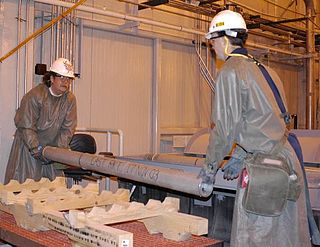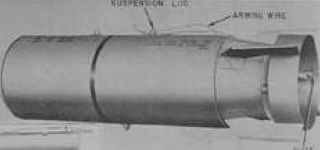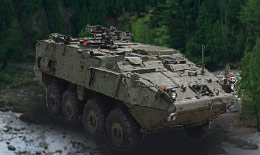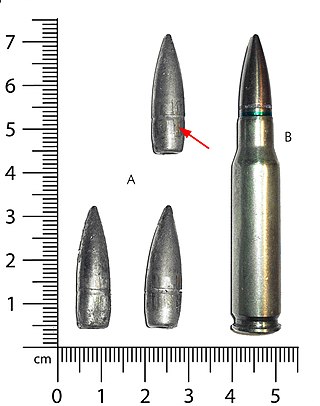Related Research Articles

Chemical warfare (CW) involves using the toxic properties of chemical substances as weapons. This type of warfare is distinct from nuclear warfare, biological warfare and radiological warfare, which together make up CBRN, the military acronym for chemical, biological, radiological, and nuclear, all of which are considered "weapons of mass destruction" (WMDs), a term that contrasts with conventional weapons.

A flechette is a pointed steel projectile with a vaned tail for stable flight. The name comes from French fléchette, "little arrow" or "dart", and sometimes retains the acute accent in English: fléchette. They have been used as ballistic weapons since World War I. Delivery systems and methods of launching flechettes vary, from a single shot, to thousands in a single explosive round. The use of flechettes as antipersonnel weapons has been controversial.

The .338 Lapua Magnum is a rimless, bottlenecked, centerfire rifle cartridge. It was developed during the 1980s as a high-powered, long-range cartridge for military snipers. It was used in the War in Afghanistan and the Iraq War. As a result of this, it has become widely available.

The Tooele Chemical Agent Disposal Facility or TOCDF, is a U.S. Army facility located at Deseret Chemical Depot in Tooele County, Utah that was used for dismantling chemical weapons.

The M2 Mortar is a 60 millimeter smoothbore, muzzle-loading, high-angle-of-fire weapon used by U.S. forces in World War II, the Korean War, and the Vietnam War for light infantry support.

The Chemical Corps is the branch of the United States Army tasked with defending against chemical, biological, radiological, and nuclear (CBRN) weapons. The Chemical Warfare Service was established on 28 June 1918, combining activities that until then had been dispersed among five separate agencies of the United States federal government. It was made a permanent branch of the Regular Army by the National Defense Act of 1920. In 1945, it was redesignated the Chemical Corps.

The M2 4.2-inch mortar was a U.S. rifled 4.2-inch (107 mm) mortar used during the Second World War, the Korean War, and the Vietnam War. It entered service in 1943. It was nicknamed the "Goon Gun" or the "Four-Deuce". In 1951 it began to be phased out in favor of the M30 mortar of the same caliber.

An assault rifle is a selective fire rifle that uses an intermediate cartridge and a detachable magazine. Assault rifles were first put into mass production and accepted into widespread service during World War II. The first assault rifle to see major usage was the German StG 44, a development of the earlier Mkb 42. While immediately after World War II, NATO countries were equipped with battle rifles, the development of the M16 rifle during the Vietnam War prompted the adoption of assault rifles by the rest of NATO. By the end of the 20th century, assault rifles had become the standard weapon in most of the world's armies, replacing full-powered rifles and sub-machine guns in most roles. The two most successful modern assault rifles are the AK-47 and the M16 designs and their derivatives.

Johnston Atoll Chemical Agent Disposal System (JACADS) was the U.S. Army's first chemical munitions disposal facility. It was located on Johnston Island, at Johnston Atoll and completed its mission and ceased operation in 2000.
The M121/A1 155mm Projectile was a chemical artillery shell designed for use by the U.S. Army. It was designed to be used with approximately 6.5 lb (2.9 kg) of GB or VX nerve agents.

The M139 bomblet was an American sub-munition designed for use in warheads as a chemical cluster munition. Each spherical bomblet held 590 grams (1.3 lb) of sarin nerve agent.

The M114 bomb was a four-pound U.S. anti-personnel bomb and biological cluster bomb sub-munition. The M114 was used in the M33 cluster bomb.

The M34 cluster bomb was the first mass-produced United States Army weapon meant to deliver the chemical agent sarin (GB). A large stockpile of M34s was destroyed between 1973 and 1976.
The M138 bomblet was a sub-munition of the U.S. chemical weapon, the M43 BZ cluster bomb. The bomblet contained BZ, an incapacitating agent and was developed with the M43 in 1962. The M138s, along with all other U.S. BZ weapons were destroyed during the 1980s.

The MC-1 bomb was the first U.S. non-clustered air-dropped chemical munition. The 750-pound (340 kg) MC-1 was first produced in 1959 and carried the nerve agent sarin.

The M134 bomblet was a U.S. chemical sub-munition designed for use in the Honest John rocket during the 1950s. The weapon was never mass-produced and was supplanted in 1964 by an improved design, the M139.

The M1135 Nuclear, Biological, Chemical Reconnaissance Vehicle (NBCRV) provides nuclear, biological and chemical detection and surveillance for battlefield hazard visualization.

The 7.62×51mm NATO is a rimless, bottlenecked rifle cartridge. It is a standard for small arms among NATO countries.
The United States chemical weapons program began in 1917 during World War I with the creation of the U.S. Army's Gas Service Section and ended 73 years later in 1990 with the country's practical adoption of the Chemical Weapons Convention. Destruction of stockpiled chemical weapons began in 1985 and is still ongoing. The U.S. Army Medical Research Institute of Chemical Defense (USAMRICD), at Aberdeen Proving Ground, Maryland, continues to operate.
References
- ↑ "M360 105-mm GB cartridge".
- ↑ Smart, Jeffery K. Medical Aspects of Chemical and Biological Warfare Archived 2012-08-26 at the Wayback Machine : Chapter 2 - History of Chemical and Biological Warfare: An American Perspective, (PDF Archived 2015-09-23 at the Wayback Machine : p. 51), Borden Institute , Textbooks of Military Medicine, PDF via Maxwell-Gunter Air Force Base, accessed November 13, 2008.